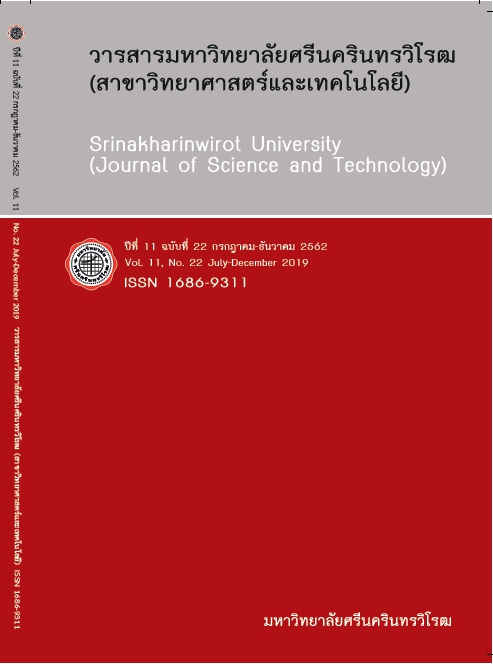ความต้านทานการสึกเหตุวัตถุ 2 ชนิด ของวัสดุบูรณะฟันที่ขึ้นรูปด้วยแคดแคมเมื่อสบกับเคลือบฟัน (TWO-BODY WEAR RESISTANCE OF DENTAL CAD/CAM RESTORATIVE MATERIALS AND OPPOSING ENAMEL )
Keywords:
Wear Resistance, CAD/CAM, Dental Ceramic, Volume LossAbstract
Introduction: Dental ceramics are known for their excellent chemical and optical properties. The wear of human enamel and of the restorative material is often a vital and esthetical concern when selecting a restorative material for any given clinical restorative treatment. The aim of this study was to determine the two-body wear resistance of dental CAD/CAM restorative materials and the opposing enamel in-vitro.
Material and Method: Twelve test specimens were fabricated from 6 types of CAD/CAM ceramic, Feldspathic ceramic (Vita MarkII), Zirconia ceramic (Incoris TZi zirconia), Lithium disilicate glass -ceramics (Emax), zirconia-reinforced lithium silicate (Celtra Duo), Hybrid ceramic (Vita Enamic) and zirconium silicate hybrid ceramic (Shofu HC), with a dimension of 2 x 2 x 5 mm for pin specimens. Enamel specimens (n =12) were prepared from the extracted human premolar teeth. Using a pin-on-disc wear tester, wear test between CAD/CAM restorative materials and enamel was performed under a constant load of 20 N, at 100 rpm for 4,000 cycles. Volume loss of enamel and CAD/CAM restorative material specimens was measured with a profilometer. Qualitative characterization of wear patterns of all test materials and enamel specimens were evaluated using scanning electron microscopy.
Result: The highest volume loss was found on Hybrid ceramic. Zirconia-reinforced lithium silicate, Zirconia ceramic and Lithium disilicate glass-ceramics have significantly less volume loss than Zirconium silicate hybrid ceramic, Hybrid ceramic and Feldspathic ceramic (p < 0.05). The wear on enamel was found lower against zirconia silicate hybrid ceramic, Hybrid ceramic and Feldspathic ceramic, but the results were not significant (p > 0.05).
Downloads
References
[2] Peng Z, Izzat Abdul Rahman M, Zhang Y, Yin L. (2016). Wear behavior of pressable lithium disilicate glass ceramic. J Biomed Mater Res B Appl Biomater. 104, 968-978.
[3] Stawarczyk B, Özcan M, Trottmann A, Schmutz F, Roos M, Hammerle C. (2013). Two-body wear rate of CAD/CAM resin blocks and their enamel antagonists. J Prosthet Dent. 109, 325-332.
[4] Savabi O, Nejatidanesh F, Shabanian M, Anbari Z. (2011). Two-body wear resistance of some indirect composite resins. Eur J Prosthodont Restor Dent. 19, 81-84.
[5] DeLong R, Douglas WH. (1983). Development of an artificial oral environment for the testing of dental restoratives: bi-axial force and movement control. J Dent Res. 62, 32-36.
[6] Peutzfeldt A, Asmussen E. (1992). Modulus of resilience as predictor for clinical wear of restorative resins. Dent Mater. 8, 146-148.
[7] Richards LC, Kaidonis JA, Townsend GC. (2003). A model for the prediction of tooth wear in individuals. Aust Dent J. 48, 259-262.
[8] Kaidonis JA, Gratiaen J, Bhatia N, Richards LC, and Townsend GC. (2003). Tooth wear prevention: a quantitative and qualitative in vitro study. Aust Dent J. 48, 15-19.
[9] Attin T. (2006). Methods for assessment of dental erosion. Monogr Oral Sci. 20, 152-172
[10] Smith BG, and Knight JK. (1984). A comparison of patterns of tooth wear with aetiological factors. Br Dent J. 157, 16-19.
[11] Mair LH, Stolarski TA, Vowles RW, Lloyd CH. (1996). Wear: mechanisms, manifestations and measurement. Report of a workshop. J Dent. 24, 141-148.
[12] Mormann WH, Stawarczyk B, Ender A, Sener B, Attin T, Mehl A. (2013). Wear characteristics of current aesthetic dental restorative CAD/CAM materials: Two-body wear, gloss retention, roughness and Martens hardness. J Mech Behav Biomed Mater. 20, 113-125.
[13] Anusavice K, Shen C, Rawls HR. (2013). Phillips' science of dental materials. 12th ed. Elsevier. St. Louis. pp. 419-120.
[14] Fischer TE, Anderson MP, Jahanmir S. (1989). Influence of fracture toughness on the wear resistance of yttria doped zirconium oxide. J Am Ceram Soc. 72, 252-257.
[15] Conrad HJ, Seong WJ, Pesun IJ. (2007). Current ceramic materials and systems with clinical recommendations: a review. J Prosthet Dent. 98, 389-404.
[16] Preis V., Behr M, Kolbeck C, Hahnel S, Handel G, Rosentritt M. (2011). Wear performance of substructure ceramics and veneering porcelains. Dent Mater. 27, 796-804.
[17] O'Brien, WJ. (2008). Dental Materials and Their selection. 4th ed. Quintessence. Chicago. pp. 12-14.
Downloads
Published
How to Cite
Issue
Section
License
Srinakharinwirot University Journal of Sciences and Technology is licensed Under a Creative Commons Attribution-NonCommercial-NoDerivs 4.0 International (CC-BY-NC-ND 4.0) License, Unless Otherwise Stated. Please Read Journal Policies Page for More Information on Open Access, Copyright and Permissions.



